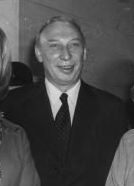Arnold Alexander Hall facts for kids
Quick facts for kids
Arnold Alexander Hall
|
|
|---|---|

Hall in 1975, attending a lunch where he won the Hambro award for 'Businessman of the Year'.
|
|
| Born | 23 April 1915 Liverpool, England
|
| Died | 9 January 2000 (aged 84) Dorney, Berkshire, England
|
| Occupation | Engineer |
| Spouse(s) | Moira Constance Dione Rathmell; Iola (Nealon) Hall |
| Children | Caroline, Elizabeth and Veronica |
| Engineering career | |
| Projects | de Havilland Comet 1 |
| Awards | Albert Medal (1983) |
Sir Arnold Alexander Hall (born April 23, 1915 – died January 9, 2000) was a brilliant English engineer, scientist, and business leader. He was known for his important work in aviation, especially for helping to solve the mystery of the De Havilland Comet plane crashes. He also played a big role in developing new aircraft and leading major aerospace companies.
Contents
Early Life and Education
Arnold Hall was born in Liverpool, England. He went to Alsop High School and later studied at Clare College, Cambridge. There, he earned a top degree in mechanical science, focusing on aeronautics (the science of flight).
He was very good at his studies, winning three special awards: the Rex Moir Prize in Engineering, the John Bernard Seely Prize in Aeronautics, and the Ricardo Prize in Thermodynamics. His love for aviation grew, and he even learned how to fly planes himself.
A Career in Aviation
In 1938, Arnold Hall started working at the Royal Aircraft Establishment (RAE). This was a key place for aircraft research in the UK. During World War II, he worked on improving aircraft design and developing better gun sights for planes.
After the war, in 1945, he became a professor at the Imperial College of Science and Technology in London. He started new labs for studying how planes fly and how their parts are built.
Leading the Royal Aircraft Establishment
From 1951 to 1955, Sir Arnold Hall was the Director of the Royal Aircraft Establishment at Farnborough. During this time, he helped build new facilities for testing aircraft. He also worked to connect the RAE with research labs in other countries, especially in Europe.
One of his most important tasks during this period was to investigate a serious problem: why several de Havilland Comet jet airliners were crashing. His team's work greatly improved our understanding of metal fatigue in aircraft.
Working with Major Aviation Companies
In 1955, he joined the Hawker Siddeley Group as their Technical Director. This was a very large aerospace company. Later, he became the managing director of Bristol Siddeley Engines Limited. This new company was formed by combining two other engine makers. His job was to bring these two companies together smoothly.
By 1963, he was leading the entire Hawker Siddeley Group. He helped expand the company and was involved in major projects, including working with France on the design of the Concorde supersonic jet. He stayed with Hawker Siddeley until it became part of British Aerospace in 1977.
Solving the Comet Mystery
One of Sir Arnold Hall's most famous achievements was leading the investigation into the de Havilland Comet 1 crashes. The Comet was the world's first commercial jet airliner, but several planes broke apart in the air.
His team at the RAE Farnborough worked tirelessly to find out why. They pioneered new methods, like putting the wreckage back together piece by piece. This helped them discover that the crashes were caused by metal fatigue around the plane's square windows. This groundbreaking work changed how aircraft are designed and tested for safety worldwide.
Awards and Recognition
Sir Arnold Hall received many honors for his important contributions. In 1953, he became a Fellow of the Royal Society, which is a very high honor for scientists. He was also knighted in 1954, earning the title "Sir."
He served as the head of Warwick University and later Loughborough University of Technology. He also received an honorary degree from the University of Bath.
From 1958 to 1959, he was the President of the Royal Aeronautical Society. He received their highest honor, the Gold Medal, in 1962. He was also recognized internationally for his work on aircraft safety and understanding metal fatigue.
His Personal Life
Sir Arnold Hall was married twice. He had three daughters named Caroline, Elizabeth, and Veronica with his first wife. He also had stepsons and stepdaughters from both of his marriages.

